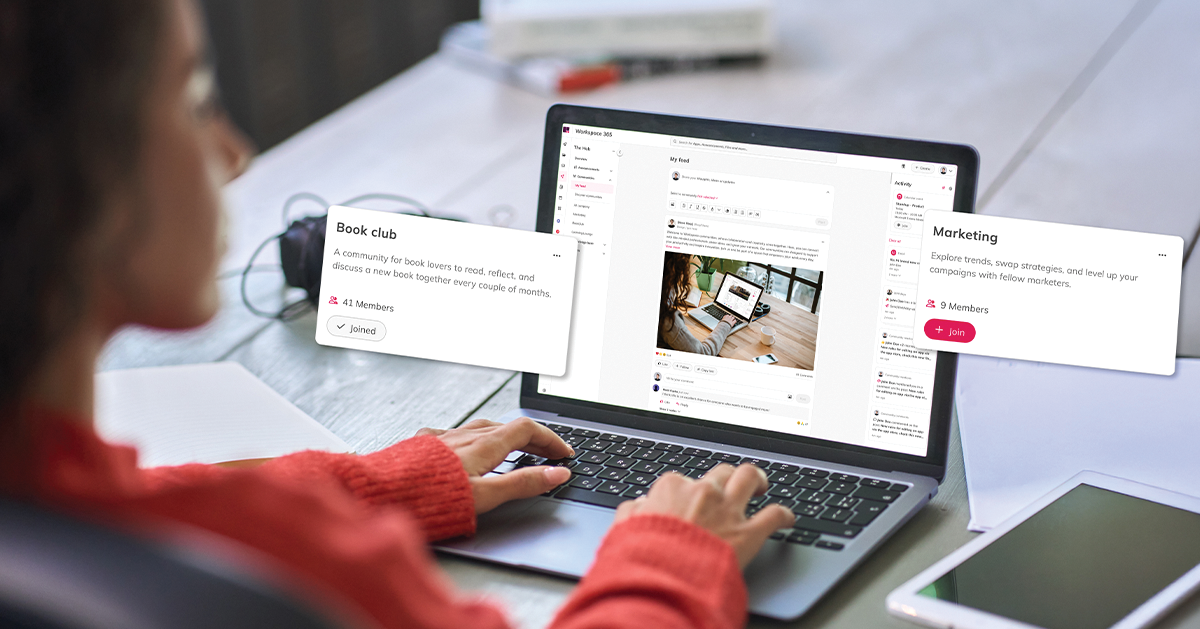Employees are very busy. Every day they have tasks they need to complete and things that need to get done. How often have you felt like there are not enough hours in the day or been overwhelmed by the length of your ‘to-do’ list?
However, there are ways that intranets, digital workplaces and IT teams can help. The way we design the everyday digital employee experience can positively impact productivity, making the working day slightly easier so that completing tasks and finding the right information is quicker and requires less effort. This can be done in various ways, including providing access to the right information and tools so they are within the flow of work, and simplifying the landscape of the workplace applications that employees need to access. When there are too many apps to access and keep open it can be overwhelming and cause inefficiency.
Combining the intranet and digital workspace
Two of the key channels which help to improve the digital employee experience are intranets and digital workspaces. They both play a role in facilitating access to the right tools, sites and content into a convenient, aggregated view that aids employees. However, they are usually regarded as two quite distinct channels, with an intranet tending to focus more on content and communications, and a digital workspace more on applications, transactions and tasks.
However, in truth, the distinction between the two is narrowing; most modern intranets or social intranets have integrations, collaboration and access to apps built into the core experience, while most digital workspaces include access to content and updates. The distinction between intranet and digital workspace is often down to the internal definitions that organisations have for their different channels; we’ve seen some intranets that are more like digital workspaces, for example.
Having two separate channels does not always make sense. A powerful approach to intranet strategy is to integrate your intranet into your digital workspace so there is just one place where employees can find everything they need. The idea of having a ‘one-stop shop’ to start the working day is very popular with employees as there is one less place to visit before starting work. Both full integration is an option, as well as integrating more elements of an intranet into a digital workspace and vice versa, so employees can smoothly switch between the two.
In this post, we’re going to explore some of the benefits of having an intranet strategy that integrates your intranet into your digital workspace, as well as how an adaptive platform such as Workspace 365 can help.
7 benefits of integrating your intranet and digital workspace
There are multiple advantages which integrating your intranet and digital workspace can bring.
1. Just one place to go
Employees don’t want to have to visit multiple places or open up numerous applications, windows or tabs to get all the information they need during the working day. Ideally, they just want one place to go where they can find what they need to kickstart their work, eliminating confusion, effort and information overload.
When you combine your intranet with your digital workspace, you create that ‘one-stop shop’ that employees are looking for. With the potential to provide access to apps, documents, conversations, emails, information and news updates, it means employees have the ideal place to start their working day, contributing to a great digital employee experience.
2. Better intranet adoption
One of the problems with intranets is the potentially disappointing levels of adoption, especially for traditional intranets which frequently focus solely on news updates and static content. This tends to be less of a problem with social intranets, but even they often attract fewer daily active users than intranet teams would like.
One of the most common issues impacting adoption is that intranets don’t help employees with their daily work, so there is no compelling reason for people to visit them; on a very busy day, the intranet is not an essential channel. Combining your intranet into your digital workspace will make the intranet essential, and adoption will almost certainly improve.
3. More impactful internal communications
One of the positive impacts of having better intranet adoption is the facilitation of more impactful internal communications. More people visiting the intranet generates more views for individual stories from a wider demographic, meaning messaging has a broader reach. This means your stories can have more impact, from driving compliance on operational updates, to achieving greater awareness about strategic initiatives, to distributing leadership communications designed to engage staff.
When an intranet is not in the daily flow of work or is poorly adopted, internal communications may simply remain unread or be missed, usually resulting in more emails getting sent, leading to inefficiency and information overload. When messages are blended into an integrated workspace which employees use for their daily work, they will see the items that matter, especially when targeted to different groups based on profile details such as role, location or division.
4. Saving time and raising productivity
By combining an intranet and a digital workspace, you save employees time and support their productivity. Firstly, most of what employees need should be in one place, facilitating better and more focused findability; without this, we waste a significant portion of the working day trying to find the things we need to complete tasks.
Secondly, it reduces context switching. Context switching – having to jump between different tasks, applications, tools and windows – is a huge drain on employee efficiency and focus, so anything that supports even a modest reduction in this will make a difference.
5. Easier and less time-consuming management
Managing intranets and digital workspaces can be complex, especially if they are targeted to different groups. In many organisations where these two channels are managed by different functions – for example, HR and IT respectively – there is collectively more effort involved. For example, ensuring there is the right governance in place can be challenging and time-consuming, especially when tackled in conjunction with efforts to drive adoption. Making changes to the systems as well as maintaining ongoing daily management is also a significant time commitment.
With just one channel to manage, the collective effort required is reduced. For example, it might be that IT functions look after the governance and set-up of your combined intranet and digital workspace, while the communications team focuses on driving adoption and managing content.
6. Faster optimisation and configuration
A traditional issue with intranets is that they can be hard to improve in order to meet the fast-changing needs and expectations of employees and their organisations, especially if they are customised. With a combined intranet and digital workspace provided through a platform like Workspace 365, which is super flexible and simple to configure, you can easily make changes to ensure your intranet and digital workspace remain relevant and deliver value. Recent events have shown how volatile the world can be, so the faster optimisation and configuration provided by managing one flexible channel can be a real advantage.
7. Reduced licensing and management costs
Of course, one of the other advantages of having an integrated intranet and digital workspace is a reduction in licensing costs – you only have one piece of software to pay for rather than two. You also save costs on the time spent maintaining two products and working on elements such as upgrades, security patches, staff training and so on.
Intranet vs digital workplace
Simplify work processes and enable your teams to maintain focus and reach peak performance levels.

The adaptive workspace: intranet and digital workspace in one
An adaptive workspace like Workspace 365 means you can combine your intranet and digital workspace into one. Some Workspace 365 customers have chosen to follow an intranet strategy that combines it with a digital workspace, meaning they do not have to purchase or manage additional intranet software. Here, employees can access everything they need in one place, available at any time and on any device.
It is worth noting that an adaptive workspace like this is not just a digital workspace with a news feed in it, but is a fully functioning social intranet integrated into Workspace 365. With Workspace 365, you can combine the elements usually associated with an intranet such as news and social feeds with those of a digital workspace like Microsoft 365 files, forms and workflow and a catalogue of apps and tools.
Also worth noting is that we want you to always be able to benefit from Workspace 365 functionalities, even if that’s from another platform. That is why it is also possible to integrate Workspace 365 elements into other platforms, such as your existing intranet.







